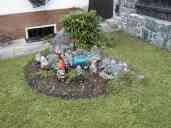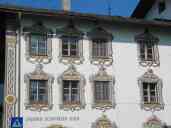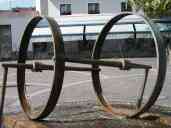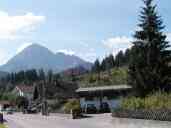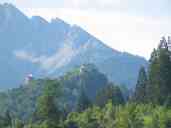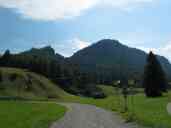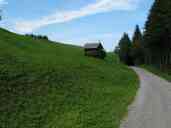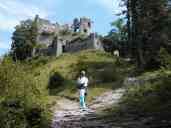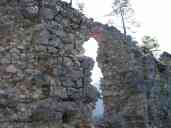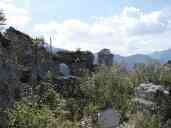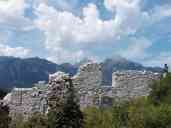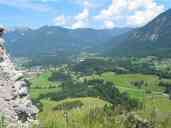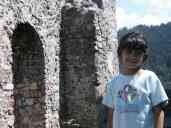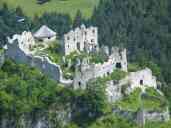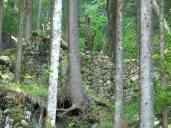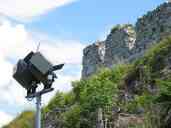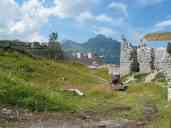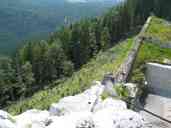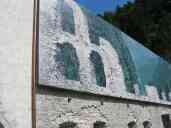Warning: This Web page contains something of a diatribe in addition to a travelogue. I make no apology.
Ever since my first visit to Bavaria in 1988, one of my favorite places in Europe has been Austria's Ehrenberg and Schloßkopf ruins. I learned about them from Rick Steves, who suggests a "Castle Day in Bavaria" that involves visiting both ruins in the morning, then taking the bus to Füssen to see both Neuschwanstein and Hohenschwangau. Rick must have a heck of a lot more energy than I do, because I've never managed more than two castles in one day.
Anyway, I fell in love with the ruins because they are isolated, unvisited, overgrown, historical, and romantic. There are two castles separated by a tiny valley (you couldn't fit a football field into it). The first time I visited, I only found the lower (and smaller) one, which dates back to 1296. Nobody else was there, and as I ate my picnic lunch I imagined what it would be like to live in this little place along with enough knights to defend it and enough peasants to feed them.
On my second visit, in 1997, I noticed that the lower ruin (Ehrenberg) had had lights added so that it would be visible from below at night. I climbed to the Schloßkopf ruin (a nasty hike; I was convinced that I'd never be healthy enough to do it again) and had one of the most wonderful experiences of my life. When I reached the crest, I found myself inside a deep old-growth forest. It was only after I had explored for quite a while that I realized that the forest was in fact the fortress, built in 1741 and destroyed as the result of a treaty in 1782, and long since overgrown by 200 years of neglect. I cannot adequately describe the peacefulness and beauty I found that afternoon, sitting in the cool shade surrounded by nature that had conquered Man's attempt to build an impregnable fortress.
I took pictures on that second trip, which I would love to post here. Unfortunately, they are buried in the garage in California. I hope to add them to this page a year from now, so that you can see what they looked like on that visit.
After those two incredible visits, I was tremendously eager to show the ruins to Pat and Xandie. I dragged them out of bed early on Monday morning so that we could catch the bus to Reutte-in-Tirol, the tiny Austrian ski village nearest the ruins. I had a bit of trouble locating the proper route out of town, but we found an information office where a friendly woman gave us a map. When I told her I had been to the ruins before, she said I would find it "viel geändert" -- much changed. She wins the understatement of the year award.
Reutte is a very typical Tirolean town, though it has become a bit upscale in the last few years. As we followed the route, we enjoyed finding an unusual fountain, garden gnomes, and buildings with scenes and decorations painted on the outer walls. After a bit, we turned a corner and spotted the lower ruins on a hilltop.
I'd never thought of the walk to the ruins as particular far, but it's different when you've got a six-year-old along. Pat and Xandie were real troupers, though. They stumped onward out of town (perhaps two kilometers to the turnoff to the ruins), up a climbing path to the museum that's being built beneath the ruins, up another steep climb to a meadow, and up yet again into Ehrenberg. There, we had lunch while gliders whooshed overhead, buzzing both our hilltop and the taller one nearby where the Schloßkopf is now clearly visible, thanks to some drastic tree-cutting.
After lunch, Pat and Xandie decided that they'd had enough climbing. The would explore Ehrenberg further while I visited Schloßkopf. In retrospect, I'm glad they made this decision, since the path was extremely strenuous and the result anticlimactic.
I've mentioned how the Schloßkopf ruins were overgrown when I last visited them. No more. In the name of "preservation" and "restoration", a team of alleged historians, led by a man named Armin Walch, has completely destroyed the experience. The forest has been completely removed by clearcutting, not only within the old castle but also around the hilltop (so that the ruins will be visible from the road below). No longer is there a cool place for contemplation; the hot sun beats down on a weed field worthy of Southern California. Even worse, the ruins are being rebuilt using modern materials and techniques. I don't know what the eventual goal is; maybe they intend to completely reconstruct the castle until it looks like Neuschwanstein, or maybe they're only going to put up enough of the walls for people to see how things were laid out. In either case, I think it's a travesty. The photographs show the stark contrast between the Middle-Ages workmanship of the original and the neatness of the "restoration". The monument to nature is gone, as is the memory of the castles' destruction.
You can read a bit more about Walch, with some sycophantic commentary by Rick Steves, in the script to one of his TV programs. If you understand German, you can also read an explanation of the project, and how it was started by someone named Fridolin Schennach. Finally, there is now an Ehrenberg web site with commentary in several languages. Interestingly, one of the other pages on that site is very explicit about the greed motive:
Managing director DI Armin Walch: "A distinct interest of the local catering business and of the hotel business as well as of travel agencies is noticeable. This is why we are working out a respective marketing strategy for 2003."
Schennach, Walch, the citizens of Reutte, and the entire nation of Austria should hang their collective heads in shame.
